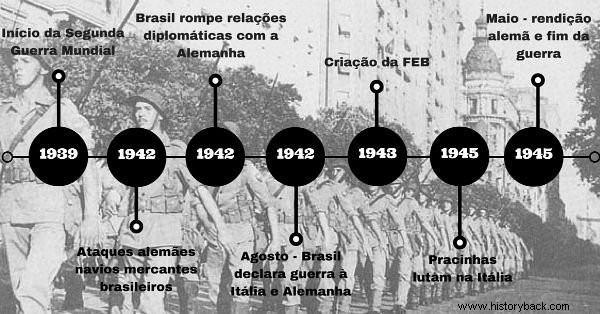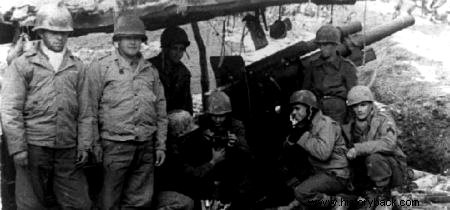The Brazilian participation in the Second World War began on September 16, 1944, lasted seven months and aimed to liberate Italy.
Brazil in World War II
Brazil entered World War II after giving in to pressure from the US government to end the period of neutrality adopted by President Getúlio Vargas.
Until 1937, Brazil maintained cordial relations with Germany, a condition that was broken the following year.
Still, the country maintained neutrality. The situation would change in 1942, when Brazil broke diplomatic relations with the Axis.
Thus, 19 Brazilian ships were attacked off the Brazilian coast by German forces, causing the death of 500 people.
There was intense popular pressure for Brazil to enter the war, and the government of Getúlio Vargas started to support the Allies.
Despite the Americans' opposition, the Brazilian government wanted to send soldiers into the conflict.
Getúlio Vargas managed to get US President Franklin Roosevelt to modernize the Armed Forces and grant loans to build a steel plant in the country.
This would be CSN - Companhia Siderúrgica Nacional - located in Volta Redonda/RJ.
In exchange, Brazil ceded land in Rio Grande do Norte to the Americans to install a military base. This was intended to be the take-off location for planes heading to Europe, and became known as the "Victory Trampoline".
Until then, critics had doubted the capacity of Brazilian participation in the conflict. They said that “it would be easier for a snake to smoke than for the FEB to board ”. For this reason, the symbol of the FEB (Brazilian Expeditionary Force) was a snake smoking a pipe.

The declaration of war against Germany and Italy took place on August 31, 1942. The Brazilian Army, however, had a small contingent, and it was necessary to call in recruits and reservists, such as doctors, nurses and lawyers.
The decree that formed the FEB (Brazilian Expeditionary Force) was signed on August 9, 1943. The FEB joined the US Army and was trained by them in Italy.
The FEB contingent consisted of 25,445,000 men to act exclusively in the war. Of these, 450 soldiers died and 3,000 soldiers were wounded during the Brazilian campaign.
The Brazilian contingent was divided into eight units:
- 1st Infantry Regiment, Rio de Janeiro;
- 6th Infantry Regiment, from Caçapava, São Paulo;
- 11th Infantry Regiment, São João Del Rei, Minas Gerais;
- Four artillery groups;
- 9th Engineering Battalion, Aquidauana, Mato Grosso do Sul;
- 1st reconnaissance squadron;
- 1st Health Battalion;
- special troops and 67 nurses.
The newly created Brazilian Air Force (FAB) also participated in the conflict.
Under the motto of “Senta a Pua ”, its main unit was the 1st Fighter Aviation Group (GAC), equipped with P47 Thunderbolt aircraft.
It consisted of 374 military personnel and 28 aircraft, of which 16 were shot down, five pilots were killed in combat and five were taken prisoner.

Brazil's Participation in World War II
Brazilian soldiers arrived on July 16, 1944 in Italy. Fighting alongside the US army, the Brazilians managed to expel the German army that was still resisting in northern Italy.
In September 1944, Brazilian soldiers took Massarosa, Camaiore and Monte Prano. In early 1945, they helped to conquer strategic points such as Monte Castelo, Castelnuovo and Montese. The war ended in May 1945.
The bodies of the 454 soldiers killed during the conflict remained in the Pistoia cemetery in Italy until 1960. In October of that year, the remains were transferred to the National Monument of the Dead in World War II, located in Rio de Janeiro.
P>End of War
After the signing of the German surrender, the FEB began to be demobilized soon in Italy.
The trip of the Brazilian contingent to Europe increased the internal contradictions of the government of Getúlio Vargas. After all, Brazilians went to fight a dictatorship, but they lived under an anti-democratic regime.
Afraid that these soldiers, now experienced, could turn against the government, Vargas hastens to disband the military contingent.
Later generations would ridicule the efforts of Brazilian soldiers, claiming that they went to fight in an unimportant place already "forgotten" by the German Army.
However, since the late 1990s, new scholars have been raising new documents and giving Brazilian soldiers a dignified place in history.
Curiosities
At least one Brazilian was sent to a Nazi concentration camp. Brigadier Major Othon Correia Netto had his fighter shot down in the attack on the Casarsa bridge, in Italy, on March 26, 1945. Taken prisoner, he remained in a concentration camp in Germany until April 29.
Brazilians even faced temperatures of minus 20 degrees in the Apennines.
Airman Alberto Martins Torres is considered the greatest pilot in the history of Brazilian aviation. He participated in 100 war missions in Italy and 76 patrol missions along the Brazilian coast.
In recognition of the work done by Brazilians, several Italian cities baptized streets and squares with the name “Brazil”. In the city of Pistoia, the monument to the soldiers who fell in combat is still preserved.
Read more:
- Good Neighbor Policy
- World War II
- Questions about the Second World War
- Era Vargas
